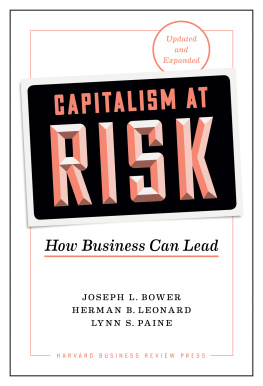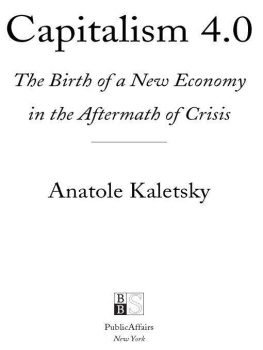Harvard Business Review Press titles are available at significant quantity discounts when purchased in bulk for client gifts, sales promotions, and premiums. Special editions, including books with corporate logos, customized covers, and letters from the company or CEO printed in the front matter, as well as excerpts of existing books, can also be created in large quantities for special needs.
For details and discount information for both print and ebook formats, contact .
Copyright 2020 Joseph L. Bower, Herman B. Leonard, Lynn S. Paine
No part of this publication may be reproduced, stored in or introduced into a retrieval system, or transmitted, in any form, or by any means (electronic, mechanical, photocopying, recording, or otherwise), without the prior permission of the publisher. Requests for permission should be directed to , or mailed to Permissions, Harvard Business School Publishing, 60 Harvard Way, Boston, Massachusetts 02163.
Preface to the Expanded Edition
When we wrote the first edition of this book over ten years ago, we were interested in fueling a public conversation about how business could address what we and others then saw as potential threats to market capitalism. We hoped that calling attention to these problems would spur leaders in business and government in the United States and abroad to take action. Since that time, the problems we wrote about have worsened, new ones have emerged, and efforts to address them have fallen far short of whats needed. Today, the very foundations of the global market system are under threat by an array of demographic, environmental, political, economic, social, and technological forces around the world.
In this new, expanded edition, we review these developments and share insights from the work we have done over the past decade to better understand what companies and business leaders can do to address these problems and put the market system on a more sustainable trajectory. We write with the hope that readers will share our sense of urgency and that more entrepreneurs and other business leaders will step up to the challenge before it is too late. The private sector has enormous potential to drive positive changeif its leaders commit to doing soand leadership by business is crucial for solving the problems at hand. We urge business leaders everywhere to seize this opportunity to rebuild public confidence in capitalism and its ability to function in a way that generates inclusive and sustainable prosperity.
______________
The problems we wrote about in the first edition were defined initially through a series of conversations with business leaders from different parts of the world. In 2007 and early 2008, in preparation for the Harvard Business Schools centennial celebration, we held a series of forums with business leaders in Europe, Asia, Latin America, and North America to learn what issues were on their minds and how their concerns might inform our research and teaching over the next decades. The World Bank had recently published projections for the global economy out to 2030, and we were particularly interested in these leaders reactions to those projections and, more generally, in their own views on the future of the global market economy. How did they see it developing? What problems did they anticipate? What opportunities lay ahead?
It was a time of great optimism and limitless possibilityjust before the financial crisisand we expected the group as a whole to foresee a continuation of global growth and rising standards of living. We also expected them to deliver a (relatively) clean bill of health for a system that had lifted 450 million people out of poverty in the previous two decadesan achievement that many economists attributed to the spread of markets and open trade across the globe.
What we actually heard was different. Many of the participants, while applauding the achievements of markets and open trade, shared what they perceived to be looming problems that needed to be addressed for global growth to continue and for the market system to maintain its political and social legitimacy. They cautioned that continued progress was far from assured, and some worried that failure to address these problems would give rise to forces that could undermine or even destroy the system. That is why we called this book Capitalism at Risk .
As described in , the business leaders identified several core problem areas and one overarching concern. The ten core areas are as follows:
- The financial system
- The state of trade
- Inequality and populism
- Migration
- Environmental degradation
- Failure of the rule of law
- The state of public health and general education
- The rise of state capitalism
- Radical movements, terrorism, and war
- Pandemics and disease
The eleventh, and overarching, concern was the inadequacy of existing institutions of governancecorporate, national, and internationalto deal with the other ten issues. Our leaders feared that without improvements in governance and management at all important levels of society, the ten underlying problems would only get worse. They worried that those worsening problems would, in turn, lead to economic stagnation, social unrest, political upheaval, natural collapse, military conflict, or other outcomes that would fatally weaken the market system and the social and political conditions necessary to sustain it. This dynamic is shown in . Because of the serious and far-reaching consequences of neglecting these eleven problems, we called them threats or potential disruptors .
As the participants in our forums discussed these disruptors and the interrelationships among them, we noted a recurring reaction. As one of the leaders put it, Weve thought about every one of these problems beforebut we never thought about all of them on the same day before and when you do that, you see not only that they are interconnected, but that they are reinforcing one another.
We argued, as did many participants, that business needed to take a leadership role in addressing the threats both because governments alone could or would not solve them and because business had distinctive skills and capabilities that could help. We argued further that companies could do so in ways that made strategic sense and could enhance their own growth and future profitability.
In this revised edition, we develop this argument further and offer additional examples of private-sector leadership. Like the earlier examples, the new ones describe companies that are introducing new business models, driving industry collaboration, and mobilizing cross-sector coalitions to help mitigate various problems or otherwise strengthen the market system.
Our vision of business leadership has challenged received wisdom and conventional economic thinking about the role of business, and in the previous edition of the book and this one, we have addressed what we know to be the standard objections. We hope that the line of thinking we put forth here will draw more business leaders into the debate and encourage them to take up the challenge of transitioning to a more sustainable form of capitalism.
Capitalism at Even Greater Risk
Over the past decade, we have continued to study the issues identified in our earlier work and to write case studies about business leaders and companies efforts to address them. Despite some noteworthy examples, however, these efforts in the aggregate have fallen dramatically short of whats needed to right the system. The language of sustainability has become widespread, but the activities undertaken in its name have been modest at best. While the CEOs of leading institutional investors such as BlackRock and Vanguard have called on companies to pay more attention to the macrochallenges facing society, capital-market pressures to produce predictable quarterly returns have kept many boards and management teams focused on short-term financial results, crowding out discussion and planning for larger, longer-term issues.









